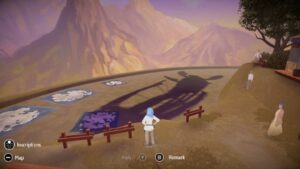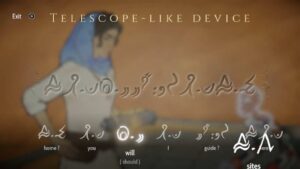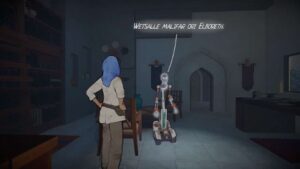Conlangers are generally aware that their hobby is a little bit inaccessible. It’s one thing that you need some knowledge of linguistics to invent interesting languages, but quite another that it takes a similar level of knowledge to understand and appreciate the decisions made in someone else’s conlang. A detailed noun class system can subtly express a lot of cultural nuances… but only to an audience who knows what a “noun class system” even is. This nuanced inaccessibility is a trait which the medium shares with the 2019 video game Heaven’s Vault, developed by the English game studio Inkle. The game takes an experimental approach to language, game mechanics and narrative, and this is at the root of both its greatest strengths and biggest weaknesses.
This is part three of a serial about conlangs – i.e. invented languages – and their role in the world of video games. Part one can be found here, and part two can be found here.
Heaven’s Vault is fascinating on a conceptual level. You take control of the character Aliya Elasra, apparently the only remaining archaeologist in a civilization spread across a landscape of small moons (the word ‘moon’ is used loosely here, as the disconnected landmasses don’t seem to be orbiting anything in particular). Alongside her robot companion Six, Aliya travels between the moons and makes a series of archeological discoveries, enabling her to locate new moons with new artefacts to be found – and that’s the basic gameplay loop which carries us through the story.
More often than not, Aliya’s artefacts feature instances of Ancient – an ancient language invented for this game, used by the precursors of the society we see in the game. The most tangible measure of progress in the game is the growth of Aliya’s vocabulary in Ancient, allowing the player to translate increasingly complicated sentences. At no point during the story are the text samples a necessity to continue the story, but if you understand them, they can inform your decisions as you play the game. In this way, the language is a constant influence on how you play the game, without getting in the way of the game’s other elements.
The ideas here are very creative and exciting to me, so it’s with some hesitation that I admit that I think its execution lets it down. I played the game in sessions of one or two hours at a time, and in every session, I’d come across some new variety of glitch – sometimes very intrusive, other times less so. Often it would just be the camera moving to an impractical angle, but other times, I ended up having to reboot the game to get rid of the glitch. One example is when one of the Ancient words got stuck in a specific part of the screen in every translation section, covering up the words that were actually supposed to be there.

A bigger issue for me, though, is that I’m afraid I would be impatient with the game’s pacing even without the technical issues. A lot of the time, the dialogue and the characters’ movements are simply very slow. The game is designed to be played several times, letting the player experience different versions of the story while understanding more of the written language in each iteration, but I ended up abandoning it after my first playthrough. Which is a genuine disappointment for me, because I really did enjoy exploring the galaxy and learning Ancient through the game’s mechanics.
But let’s not dwell on that. I don’t actually mean to write a review of the game – what I want to discuss is its language! Like the languages in Chants of Sennaar, which I discussed last week, Ancient is a written language of ideograms. Each symbol represents some semantic or grammatical entity, and the meaning of the different words can to some extent be predicted from the symbols they consist of. But Heaven’s Vault only has one conlang, as opposed to Sennaar’s five, and you can feel that the time has been devoted to that single script to let it carry the player’s attention through the whole game.
The method for learning the script is mechanically interesting, but it is also one of the game elements which I have mixed feelings about. During the translation segments, the player is put into Aliya’s perspective, which means that you’re aided by her intuition. In the beginning of the game, Aliya has a personal interest in Ancient, but doesn’t know the meaning of any of the words. Still, she has a sort of ‘sense’ of the words, letting her provide the player with a few different options for each word, and it’s up to the player to pick between these based on context. If you guess the correct translation for the same word in two different texts, Aliya’s intuition about the word will turn to certainty, and the canonical translation is added to her vocabulary.
Mechanically, this works fine, but the linguistic alarm bells in the fussiest and shadiest little corner of my mind can’t help going off when the player character confidently proclaims the meaning of a word in an unknown language after seeing it exactly twice, and in ambiguous contexts. And even though I rationally understand that Aliya’s certainty is actually the game’s way of telling me I guessed the right answer, I can’t help feeling that the matter can’t be settled yet when the evidence in the game itself is far too thin to draw a real conclusion. In the same way, I lose a bit of the immersion when Aliya can consistently guess the meanings of words based on essentially nothing. Knowing even a little bit about how languages work, it quickly becomes clear that the translation segments here do not represent the real-life process of decoding an unknown language.

Am I a huge pedant for caring about that? Yeah, obviously! The game never claimed to simulate real-life language analysis, and it’s not as though I judge Mariokart for its ability to make me feel like I’m driving a real car (if anything, the reverse is true). I’m similarly tempted to point out how Ancient is largely identical to English in terms of syntax and vocabulary – which makes it a fairly dull conlang outside the context of a game – but I also understand that it would probably be too complicated to be effective as a game mechanic if you had to uncover a whole new set of syntactic rules alongside the words themselves, especially in a game that’s already relatively experimental. Still, I think it’s a shame that the script in Heaven’s Vault feels less immersive than those in Chants of Sennaar when the former has a far larger vocabulary and a much more constant presence than any individual language in the latter game. Both games depend on the player’s ability to decode an invented written language, but Heaven’s Vault applies a more artificial framework to the translation process.
Ancient also goes beyond Sennaar’s languages in another significant way: It exists in a spoken form. The game doesn’t contain any sound files of spoken Ancient, but the spoken language is sometimes expressed through characters’ speech bubbles. When this happens, the language is written with Latin letters, giving the player a general sense of its pronunciation. But I have to admit that I never got much understanding of the spoken language and whether it had any underlying grammar. If I’d had the patience for multiple playthroughs, I can easily see myself getting out a couple of notebooks and collecting samples of spoken Ancient to compare and analyse – and I take that as a testament to the depth of the ideas in this game. There’s plenty of potential for fascination and obsession, and only the game’s own incidental bothersomeness gets in its way.

For a blog entry that ostensibly isn’t a review, I feel that I’ve been a bit more critical in this text than I generally like to be, and so I want to end on a positive note. After playing the game, I watched a recording of a talk by one of its lead developers, and with new insight in the intentions behind the game, I passionately appreciate its vision. In terms of interactive storytelling structure, Heaven’s Vault is an extremely elegant experiment, and I really admire the creativity and ambition that goes into weaving a conlang into a game of this type. If Inkle decides to make a game building on these ideas, but with fewer glitches and more streamlined gameplay, I’ll be first in line.
In next week’s entry, I will discuss a game which I almost can’t praise highly enough, but which is very dependent on not knowing too much going into it – and I will definitely be spoiling some details that are much more fun to discover for yourself. So to those who have the opportunity, I recommend checking out the game Tunic before you read next week’s entry!
Gustav Styrbjørn Johannessen has a Master’s degree in Linguistics from Aarhus University. One time, he came up with a phonetic writing system to label his spice jars. It has barely ever led him to confuse the salt and the sugar, so he considers it a success.








1 thought on “Conlangs & computer games, part 3: Ancient robots in space!”